The man approached the teller and proceeded to undertake his deposit, transfer money to his line of credit and ended his sequence by a request to order cheques, a package of fifty would suffice, but a greater quantity if less expensive would also be considered. “Well, the best for this model, – which appeared to be the basic standard issue, not the custom one with your dog licking the bowl, the kitschy violin or wife and kids besides an RV-would be $47.82 plus applicable taxes” Wow. You would think they would almost give the cheques away since they make money on clearing them and the monthly fee for maintaining the account. Its strikes you that the individual is like a cow in the abattoir: they will sell every possible scrap of meat off them with the balance on a short jaunt to the glue factory. I suppose the recalcitrants doth they protest too much become a metaphorical bar of soap or lampshade.

Read More:http://www.toutfait.com/issues/issue_2/Articles/velthuis.html ---With the "Cheque Bruno a quartet of financial readymades had been completed. Duchamp created the first of them in 1919 © 2000 Succession Marcel Duchamp ARS, N.Y./ADAGP, Paris. for his dentist Tzanck, followed five years later by a bond issued to finance a roulette project. In the same year that he signed Philippe Bruno’s check (1965), Duchamp had also converted a Czech membership card into a readymade by wittily naming it "Czech Check." Duchamp’s four financial readymades have hardly received attention
“thats quite a bit, there is no larger quantity less expensive? And what of people who have little money in their account?” Well, apparently, the poor hangers on, considered fortunate these days to have an account, as if its some form of status and distinction, can actually go to their branch and purchase individual cheques for a couple bucks. Then when you think of all those who have no accounts and bring their welfare cheques or other income supplements to roadside cheque cashing services. Banks are to mediate the use of money as a medium of exchange but are basically a quasi-criminal monopoly operating under state sanction. They addict the financially illiterate to credit then gouge out profits like the merchant of venice on their hide thereafter. There are some alternative explanations out there on Shakespeare’s merchant and they make more sense than short circuiting the entire charade like a millstone on the yids. Very ingenious. The sad part is that this has been going on for centuries. Hard to blame people trying to cover their month ends through odd cash jobs and utilizing exchange of services or appropriating from First Nations and de-quantifying nature from man and using the means of barter to escape the slavery not of money, but of the management of money.

Read More:http://www.toutfait.com/issues/issue_2/Articles/velthuis.html---The status of the Czech Check and the Cheque Bruno is particularly ambiguous, as if Duchamp’s interpreters have understood his lesson all too well (or not at all). The checks have never been institutionalized as proper works by Duchamp. At the same time, they have been noticed too often to live in oblivion altogether.---
This seems very significant and brilliant, pertaining to the fundamental issue of how value comes into being, how the efforts to quantify value corrupt it of aesthetic, spiritual and overall artistic and poetic merit; and , crucially deals with the erection of boundaries. Reading Jean Genet and his literary work when he stayed with the Palestinian Fedayeen caught between the both Jordan and Israel, he explored the concept of crossing boundaries, of going through rarely used passages and gates and understanding the permeability of how people actually function and how money and politics negates the impulse by channeling the issue of identity within the most narrow of stereotypical frameworks serving to repress or a best offering limited valves of disavowal:
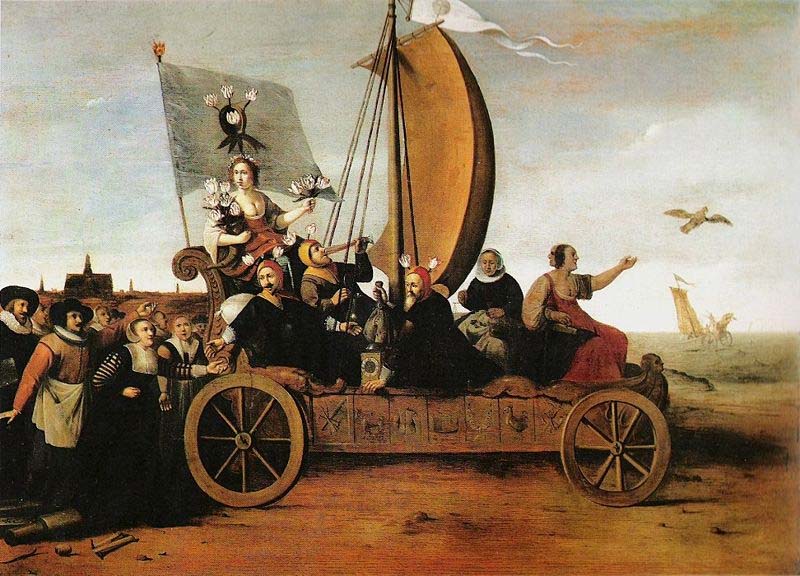
Read More:http://www.soenyun.com/Blog/2010/08/04/tulip-mania-paintings/ ---While looking for images of this painting I ran across a couple other interesting depictions of the tulip mania. Both were painted by Dutch artists closer to the actual tulip market crash, and both paintings reside in Haarlem’s Frans Hals Museum. Hendrik Gerritsz Pot painted an allegory of Flora’s Wagon of Fools around 1640. This painting shows a cartload of tulip-deranged wackos leading the common workers into the sea. Substitute Wall Street bankers for the tulip-snorting loonies and I think it has special resonance for us today.---
…Duchamp’s financial documents both specify and generalize his overall artistic enterprise. Rather than addressing all institutions of the art world, they nail art down at one specific institution: the art market. Rather than questioning artistic worth, they address the general question of how value comes into being. As epitomes of the readymade, Duchamp’s financial documents defy general interpretations. They may be fingerprints of a charlatan, but it is impossible to deny their critical potential as readymades. Conversely their refined critique of the art market’s perversity can only be seen by ignoring Duchamp’s biography; it recounts how Duchamp was highly implicated in the market mechanisms the financial documents allegedly critique.Read More:http://www.toutfait.com/issues/issue_2/Articles/velthuis.html
About a decade ago, there was a very heated exchange involving the respected critic Donald Kuspit over Marcel Duchamp and his image as part of a work juxtaposed with Hitler by Rudolf Herz. Kuspit called Duchamp a terrorist who had nearly destroyed art. A nihilistic bent that was met with resistance from Barowitz and Nauman, also a couple of heavyweights. Its a complex issue, and in a sense Duchamp would have understood Kuspit’s argument that was asserted in Kuspit’s Money values or At Values article. Duchamp was graspng with the same issue of money, banking and speculation had absorbed art as an industry and how artistic and financial value becomes created arbitrarily through social exchange. The speculative character of money having only a peripheral relation to the work of art. Ultimately, the relationship expresses intrinsic qualities which recognize that value, art wise or in financial terms, are interlocked in a circuit of merely symbolic exchange which is almost impossible to short circuit as Duchamp discovered.
ADDENDUM:
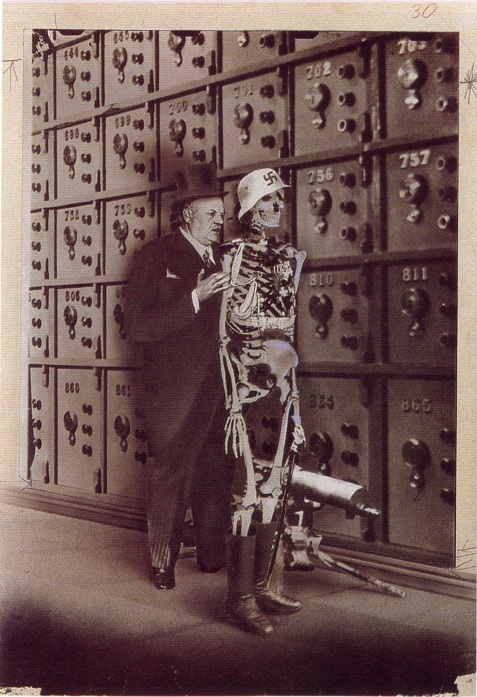
Read More: http://mtislav.blogspot.com/2011/11/le-photomontage-du-politiqui-n8-datait.htmlfrom 1934.Have never seen this one before from John Heartfield, but it conveys the rather sordid relation between money, populism and its alleged qualities of authenticity we are told to cherish.
Again: Whereas his other readymades questioned the value of artistic craftsmanship in a capitalist society, the T
k Check traveled the opposite direction by importing this value in the world of finance.The Monte Carlo Bonds (Obligations pour la Roulette Monte Carlo) were issued five years later to raise funds for a gambling project. In an interview Duchamp recalled that he created the bonds “to make capital to break the Monte Carlo bank” : roulette would be converted into a game of chess by removing luck from the table and relying on mathematical calculations instead. Like the Tzanck Check, the Monte Carlo Bond is a look-a-like of the actual financial document. On top of the bond is a photograph by Man Ray of Duchamp’s face covered in shaving foam, while the background reads “moustiques domestiques demistock” (“domestic mosquitoes half-stock”). The document is signed by Rrose Sélavy, president, and Marcel Duchamp, one of Sélavy’s administrators. Of the thirty bonds that were created, about twelve would eventually be sold for 500 francs each. All owners of the bonds were entitled to an annual dividend of 20%.Read More:http://www.toutfait.com/issues/issue_2/Articles/velthuis.html a
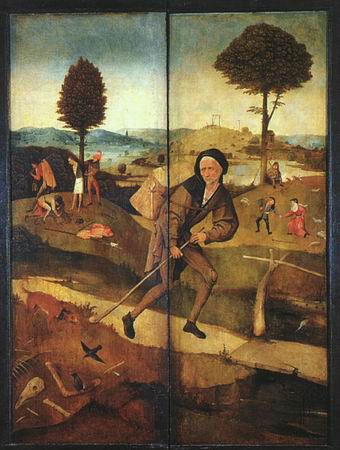
Read More:http://www.toutfait.com/issues/issue_2/Articles/velthuis.html Bosch. The Path of Life. Door cover for the Haywain. ---Given his condemnation of the art market, it is hardly surprising that rather than getting involved in commercial transactions, Duchamp gave away the major part of his oeuvre. Collectors are said to have rarely left his studio without a gift. When the art collector and couturier Jean Doucet financed the production costs of Duchamp’s second optical machine, the Rotary Demisphere the artist gave him the machine in return. He insisted that the transaction was "an exchange and not a payment." Furthermore, Duchamp seemingly avoided involvement in the art world, urged his main patron Walter Arensberg not to lend his works to others, and frequently denied requests to have his art exhibited. "All expositions make me ill," he wrote to Doucet. Duchamp disapproved of commercial transactions in art in particular and wrote in a letter to Alfred Stieglitz that....
…Duchamp’s financial documents obviously criticize an art world where the signature certifies both artistic and economic value, where the authority of the artist and the authenticity of the work are seemingly all that counts. And if Duchamp had to face the fact that people ended up ascribing aesthetic value to his readymades whereas his choices were informed by aesthetic indifference, the financial documents were an effective remedy. Thus Duchamp’s readymades express the intent “to eliminate art as an institution,” as avant-garde’s advocate Peter Bürger puts it:…
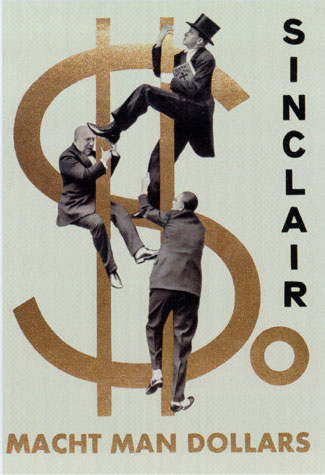
Image: http://johnheartfield.tumblr.com/page/5 We can have all the Dodd-Frank you like. Enough to choke a horse, but liberal reform may actually reinforce the most heinous elements of the money and credit system and the Fed or central banks efforts to support banks at all costs to the detriment of the citizen. Compromise seems to mean submission.
…When Duchamp signs mass-produced objects…and sends them to art exhibits, he negates the category of individual creation. The signature, whose very purpose it is to mark what is individual in the work, that it owes its existence to this particular artist, is inscribed on an arbitrarily chosen mass product, because all claims to individual creativity are to be mocked. Duchamp’s provocation not only unmasks the art market where the signature means more than the quality of the work; it radically questions the very principle of art in bourgeois society according to which the individual is considered the creator of the work of art. ( ibid.)
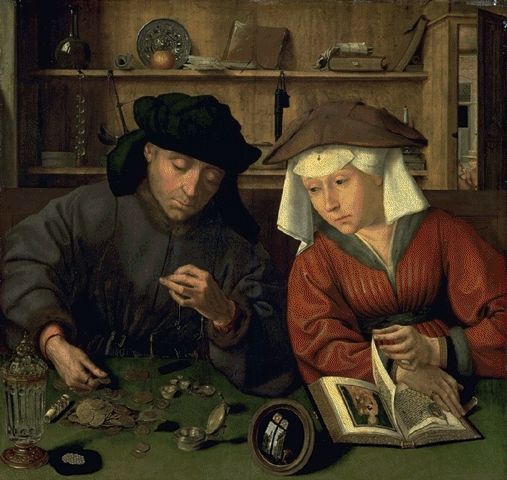
Read More:http://www.oceansbridge.com/oil-paintings/product/2661/thebankerandhiswife1514---The Banker And His Wife 1514 Artist: Quentin Metsys Location: Louvre National Gallery Medium: Oil Painting on Canvas Delivery: Delivered within 14 to 21 days Shipping: FREE Shipping & Handling Our Price: $356.00
————————————————————
Probably the main motivation for Duchamp to partake in these commercial activities was simply to make a small profit. Since he had given most of his works away, his reputation had not been translated into economic terms. Apart from commercial reasons, the replicas had artistic repercussions which Duchamp did not eschew. The American painter Douglas Gorsline, for instance, who asked Duchamp to sign his bottle-dryer, got the following reply in the mail: “In Milan I have just made a contract with Schwarz, authorizing him to make an edition (8 replicas) of all my few readymades, including the porte bouteille [bottle-dryer]. I have therefore pledged myself not to sign anymore readymades to protect this edition. But signature or no signature, your find has the same ‘metaphysical’ value as any other ready-made, [it] even has the advantage to have no commercial value.” (Naumann)
Thus Duchamp suggested that his signature decreased rather than increased the value of his readymades, since the commercial value that the signature generated was a vice rather than a virtue.Read More:http://www.toutfait.com/issues/issue_2/Articles/velthuis.html





 COMMENTS
COMMENTS